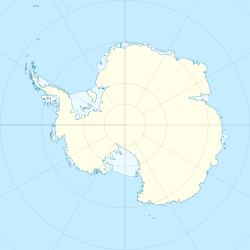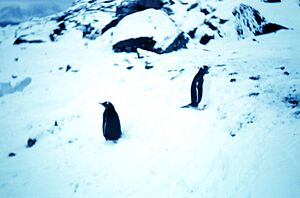Signy Island facts for kids

Signy Island base and panorama
|
|
| Geography | |
|---|---|
| Location | Southern Atlantic Ocean |
| Coordinates | 60°43′S 45°36′W / 60.717°S 45.600°W |
| Archipelago | South Orkney Islands |
| Total islands | 1 |
| Area | 19 km2 (7.3 sq mi) |
| Length | 6.5 km (4.04 mi) |
| Width | 5 km (3.1 mi) |
| Highest elevation | 288 m (945 ft) |
| Administration | |
| Administered under the Antarctic Treaty System | |
| Largest settlement | Signy Research Station (pop. 5) |
| Demographics | |
| Population | 5 |
| Pop. density | 0.26 /km2 (0.67 /sq mi) |
Signy Island is a small island located in the South Orkney Islands of Antarctica. It's a special place because it's part of the subantarctic region, which means it's close to the Antarctic Circle. A Norwegian whaler named Petter Sørlle gave the island its name after his wife, Signy Therese.
The island is about 6.5 kilometers (4 miles) long and 5 kilometers (3 miles) wide. Its highest point reaches 288 meters (945 feet) above sea level. A lot of Signy Island is always covered in ice. Temperatures usually range from 0°C (32°F) to about -10°C (14°F) in winter. But it can get as warm as 12°C (54°F) or as cold as -44°C (-47°F)! Signy Island is separated from Coronation Island by Normanna Strait and from Moe Island by Fyr Channel.
The British Antarctic Survey (BAS) runs a science station on Signy Island called the Signy Research Station. Scientists there study biology. The station first opened on March 18, 1947. Before that, it was a whaling station in the 1920s. Until 1996, people lived at the station all year. Now, it's only open from November to April, hosting about 10 people.
Contents
Exploring Signy Island's Geography
Many parts of Signy Island have been mapped and named by different groups exploring Antarctica. The first map was made in 1912 by Norwegian whaling captain Petter Sorlle. Later, explorers from the Discovery Investigations (DI) visited and mapped the island in 1927 and 1933. Finally, in 1947, the Falkland Islands Dependencies Survey (FIDS) created detailed maps. These maps helped name many of the island's features. Other names were added later by the UK Antarctic Place-Names Committee (UK-APC).
The West Coast
The very top of Signy Island is called North Point. Southwest of the coast, you'll find Spindrift Rocks. These rocks are about 15 meters (49 feet) high and don't have ice on them. They were named because of the sea spray, or "spindrift," that flies over them during strong westerly winds.
South of North Point is Williams Haven, a small bay with a large sea cave. This cove was named after David D. Wynn-Williams, a BAS scientist who studied tiny living things. Richard Point marks the south entrance of Williams Haven. It's named for Kenneth J. Richard, a BAS technician.
Deschampsia Point is on the northwest side of Signy Island. It was named after the Antarctic hair grass, Deschampsia antarctica, which grows on the nearby slopes.
Further south, Lovegrove Point marks the north side of Express Cove. This small cove has a very bumpy shoreline with many islands and rocks nearby. It was named after an American ship called Express that visited the area in 1880. Foca Point marks the south side of Express Cove. It was named after a whale catcher ship called Foca. Foca Point also marks the north side of Foca Cove.
The next important spot is Thulla Point, which doesn't have ice. It was named after the Norwegian steamship Thulla. Thulla Cove is located just south of this point.
Inland Lakes on the West Side
Southeast of Thulla Point and Cove, you'll find several lakes. Amos Lake is closest to the shore and is named for Stephen C. Amos, a BAS scientist who studied fresh water. Northeast of Amos Lake is Spirogyra Lake, named for the green algae Spirogyra that grows there in summer. To the east is Light Lake, named after another BAS scientist, Jeremy J. Light. Tranquil Lake is a peaceful lake fed by melting ice, named for its calm location.
Port Jebsen is a bay on the coast near the south end of the island. It was named by Petter Sorlle after Jebsen Point. Jebsen Rocks are a chain of rocks near Jebsen Point.
South of Jebsen Point is Cummings Cove. This cove was named for E. T. Cummings, a radio operator. The BAS has a small hut at Cummings Cove where scientists can stay. Bothy Lake, a small lake at the head of the cove, was named after this hut. Twisted Lake, northeast of Cummings Cove, was named for its unusual shoreline. Porteous Point marks the south entrance of Cummings Cove.
Even further south is Hydrurga Cove. It was named after the leopard seals, Hydrurga leptonyx, which are often seen there.
The East Coast
The first big feature on the east coast is Stygian Cove. It's named because the tall cliffs of Robin Peak make it feel dark and gloomy. Next to it is Berry Head, which separates Stygian Cove from Tern Cove. Tern Cove has three small islands and is named for the colony of Antarctic terns that live on the southernmost island. Inland from Berry Head is The Wallows, a low area with a small pond. It's named because elephant seals like to wallow, or roll around, in the mud there during summer.
South of that is Rootes Point, named for David M. Rootes of the BAS. This point marks the north side of Starfish Cove. Starfish Cove was named because of the many starfish found there. A small rock called Powell Rock is just off the mouth of the cove, named after a whale catcher ship called Powell.
South of Starfish Cove is Borge Bay, a large bay that takes up much of the east side of Signy Island.
About 0.5 nautical miles (0.9 km) south of Borge Bay is Paal Harbour. Observation Bluff forms the north side of Paal Harbor. It was named because scientists made daily observations from there. The bluff ends at Polynesia Point, named after a factory ship called Polynesia. Rusty Bluff is a tall cliff on the west side of the harbor, named for its color and a rusty metal post found on top. Rethval Point, which has no ice, forms the south side of the entrance to Paal Harbour. It's named for the Rethval Whaling Company.
Further south is Caloplaca Cove, named after the bright orange lichens called Caloplaca that cover the cliffs around the cove. Pantomime Point marks the south entrance of this cove.
Gourlay Peninsula is a rocky, ice-free piece of land that forms the southeastern tip of Signy Island. It has three arms that reach out into the sea. Pantomime Point is the northernmost point, and Pageant Point is the central and highest point. Both were named for the interesting behaviors seen in the penguin colonies on the peninsula. The cove between Pantomime and Pageant Points is called Filer Haven. The third point is Gourlay Point, named for engineer Ronald George Gourlay.
The South Coast
Moyes Point is on the southwest part of Signy Island. It forms the east side of the entrance to Fyr Channel. It was named for William Moyes, a British government representative.
To the east, the southernmost point of the island is Pandemonium Point. It was named because of the constant noise from the penguin colonies nearby. Clowes Bay is a wide bay on the south side of Signy Island, named for Archibald J. Clowes, an oceanographer. East of Clowes Bay is Lenton Point, named for radio operator Ralph A. Lenton. Lenton Point marks the west side of Fur Seal Cove. This cove was named for the many fur seals that visit it. Inland from Lenton Point is the Hillier Moss, a wet, flat area with small pools and lots of moss. It was named for Edward R. Hillier, a BAS medical officer.
Other Inland Places
- Andreaea Plateau
- Cryptogam Ridge
- Everson Ridge
- Garnet Hill
- Gneiss Hills
- Jane Col
- Jane Peak
- Jensen Ridge
- Limestone Valley
- McLeod Glacier
- Moraine Valley
- Moss Braes
- Orwell Glacier
- Paternoster Valley
- Robin Peak
- Skua Terrace
- Snow Hills
- Spindrift Col
- Strombus Ridge
- Three Lakes Valley
- Tilbrook Hill
- Tioga Hill
- Tioga Lake
- Usnea Ridge
- Whalers Bluff
Amazing Wildlife: Signy Island's Important Bird Area
Signy Island is recognized as an Important Bird Area (IBA) by BirdLife International. This means it's a very important place for many different kinds of seabirds to breed and raise their young.
Birds that are especially important for conservation here include:
- Southern giant petrels (about 2,300 pairs)
- Wilson's storm-petrels (a huge number, around 200,000 pairs!)
- Imperial shags (800 pairs)
- Brown skuas (100 pairs)
Other birds that nest on the island are:
- Chinstrap penguins (19,500 pairs)
- Adélie penguins (16,900 pairs)
- Gentoo penguins (750 pairs)
- Antarctic prions (50,000 pairs)
- South polar skuas
- Snow petrels
- Cape petrels
- Black-bellied storm petrels
- Snowy sheathbills
- Kelp gulls
- Antarctic terns
Many Antarctic fur seals also come ashore on the island, sometimes more than 20,000 of them! Weddell seals have their pups in winter on the sea ice around the island.
See also
 In Spanish: Isla Signy para niños
In Spanish: Isla Signy para niños



